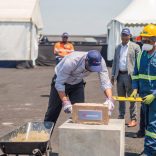Doctors at Mozambique's largest hospital give the government 30 days to avert strike
Mozambique: Surviving on indigestible roots

Aurélie Marrier d’Unienville/IFRC / Maria Mabunda prepares local river roots for her seven children and grandchildren. This is one of the only sources of food available in Chichongolo community according to the village leader.
In her crumbling mud-built home in the village of Chichongole, Mozambique, Maria Mabunda slowly stirs a meagre red paste at the bottom of her smoke-blackened cooking pot. It’s not much for a family of seven, but after two years of failed rains, it’s all they can manage.
She picks up a second pot of charred roots, known here as Tivha, and carries the two pots outside to a small straw structure where her children and grandchildren are assembled, taking shelter from the scorching heat.
An unprecedented drought in this part of the country, attributed partly to the El Niño climate phenomenon, has destroyed crops, killed livestock, dried up wells and left villagers, like Maria, struggling to survive.
Before the drought, maize, pumpkin and other fruits flourished here. Now she must make do with the tomatoes that have been rejected by a local landowner, and the Tivha roots, which lack nutritional value and taste terrible. The Tivha roots can also cause chronic indigestion.
“There is nothing else,” said Maria. “So we eat this every day.”
Maria’s children should be in school, but for months now they haven’t been able to attend. Their days are now filled with a never-ending search for food. Each morning, they wake up at 3am and begin the two-hour trek to a nearby river where they dig for Tivha roots out of the mud on the riverbed.
It’s a gruelling routine, especially on an empty stomach.
According to the local community leader, Araúja Mabunda, the drought has led to the deaths of thirteen people in the community this year, mostly the very young and the elderly, and those who were already suffering from chronic illnesses.
“We’ve never been in such a critical situation before… this year there’s not been a drop of rain and last year it only rained once,” said Araúja. “Sometimes we look up into the sky with a cup and we ask god to give us strength to be able to overcome this situation.”
He said the villagers had started tying fabric tightly around their stomachs in a desperate attempt to lessen the pain of hunger.
The Red Cross has been helping communities across southern and central Mozambique to cope with the drought situation and increase their resilience to future crises and climate-related disasters, with a combination of cash support, distribution of food and drought resistant seeds to help improve the local farming produce.
“As drought situations have longer term humanitarian consequences, the idea is to provide support that will also strengthen the people’s ability to prepare for and withstand potential crises,” said Marla Dava, programme coordinator for the Mozambique Red Cross Society.
With rains expected in October, Maria Mabunda hopes that she will be able to grow food again for her family. Now she and her fellow villagers are counting down the days and praying for rain.
“Sometimes we can’t even leave the house, such is the hunger,” said Maria. “Seeing my children suffer like this makes me cry.”
In May 2016, the IFRC launched a 110 million Swiss franc initiative to significantly scale-up Red Cross drought response activities in southern Africa, including emergency distributions of cash and efforts to strengthen the resilience of 1 million vulnerable people, with an emphasis on supporting at-risk communities to better withstand future challenges.
By: Aurélie Marrier d’Unienville












Leave a Reply
Be the First to Comment!
You must be logged in to post a comment.
You must be logged in to post a comment.